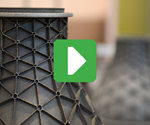Video: How Simulation Assists Directed Energy Deposition
Scrapping an AM part is potentially as costly as scrapping a machined part. Directed energy deposition is an additive process that can benefit from a resource that safeguards machining: simulation software.
Directed energy deposition (DED) is a metal additive manufacturing process often applied using a CNC machine tool or a machine that operates much like one. In some cases, technology developed for CNC machines can aid DED as well. The most notable example of this is probably simulation software, a tool for validating the build cycle before it begins. I recently spoke about this with Gene Granata of CGTech and Tim Bell, currently with Siemens, who was with BeAM Machines when this was filmed.
Transcript
Peter Zelinski, Additive Manufacturing
Directed Energy Deposition (DED) is a metal additive process often applied on the machine, very much like a CNC machine tool. That means it can use technology that aids CNC machining.
I recently had a conversation about an example of this simulation software.
Tim Bell, Siemens
We have a part in our booth today that has 11 million lines of G code. Parts about 11 inches in diameter, about 12 inches tall. It's a simulated rocket nozzle with a dual wall that allows structures inside of it. It's a very small part. If you go to the rocket engine manufacturers, they're going to want to build a very large one of these. It can easily be 500 million lines of code. Then it becomes very dicey.
Peter Zelinski
How did you first recognize the value, the need for simulation?
Tim Bell
We wrote a program; we didn't have simulation software; we drove the nozzle into the part at the end of the program. So the programmer didn't notice that, when he built the part, the very last line said ‘go back to Z zero.’ And that's what it tried to do. Had we had Vericut, we wouldn't have lost $20,000 – $30,000 in hardware and Lord knows how many hours of time we lost.
Peter Zelinski
First, describe what Vericut is, simply from the machine tool world.
Gene Granata, CG Tech
Vericut is a CNC software that takes the G-code file that Tim was just talking about, and using a digital twin of that machine, it simply executes the code. The machine kinematics are built-in.
Peter Zelinski
CG Tech began adapting this for additive about how long ago?
Gene Granata
Oh, I would say 10-15 years ago we started off into the light tape world and the tape lane technologies. In many ways, this technology that we're talking about with directed energy deposition is similar. It's got similar patterns and profiles in process sheet and controlling directions. So, not that big of a step for us. We've been in it for a long time.
Peter Zelinski
Are there any particular challenges to realizing accurate simulation of a DED process?
Gene Granata
When you're applying metal to a part and you're welding beads and laying tracks down, there are some differences and variances about how that material builds up, which is one of the biggest challenges a programmer has. As he's building a part, it's changing with every well bead you're attaching to it. So keeping track of where everything is and the more complex the part, the more challenging that is. As it builds, it will build at different rates, [and] there are different problems, problems completely unrelated in the subtractive world, that need to get incorporated into the simulation.
Peter Zelinski
In addition to using simulation to validate the tool path or the deposition path, you're also using it to validate the parameters of the process. Talk about that a little bit.
Gene Granata
In the additive world, the programmers got a whole new slew of codes that are controlling these high tech punches, like the laser, the wattage, the material flow, the gas flow, [and] how much has gone into the part; we call it a recipe of parameters. If the recipe is good, you'll get a good part and it'll build in a consistent way because you've got a program running around expecting it to build at a certain rate. If you don't build it fast enough, pretty soon you're getting farther and farther away from your work piece, and now material isn't sticking, and it's thinning out, and you have all kinds of problems with that. We're checking those parameters in Vericut so you know if you're within the guidelines for that particular metal. They could be different for different metals you're depositing as well. We can let programmers store that as a library and [it] helps them keep track of their process.
Read Next
Video: What is Directed Energy Deposition?
DED is an additive manufacturing process that builds features or parts in metal by placing material where needed.
Read MoreHybrid Additive Manufacturing Machine Tools Continue to Make Gains (Includes Video)
The hybrid machine tool is an idea that continues to advance. Two important developments of recent years expand the possibilities for this platform.
Read More3D Printing Brings Sustainability, Accessibility to Glass Manufacturing
Australian startup Maple Glass Printing has developed a process for extruding glass into artwork, lab implements and architectural elements. Along the way, the company has also found more efficient ways of recycling this material.
Read More

















